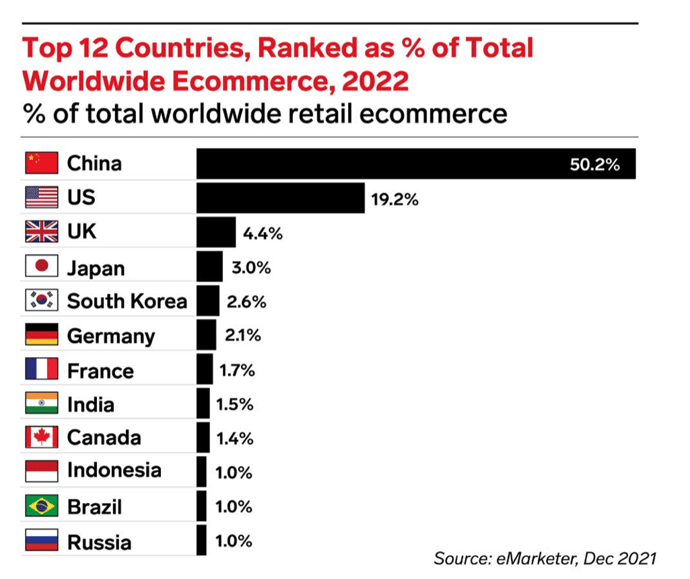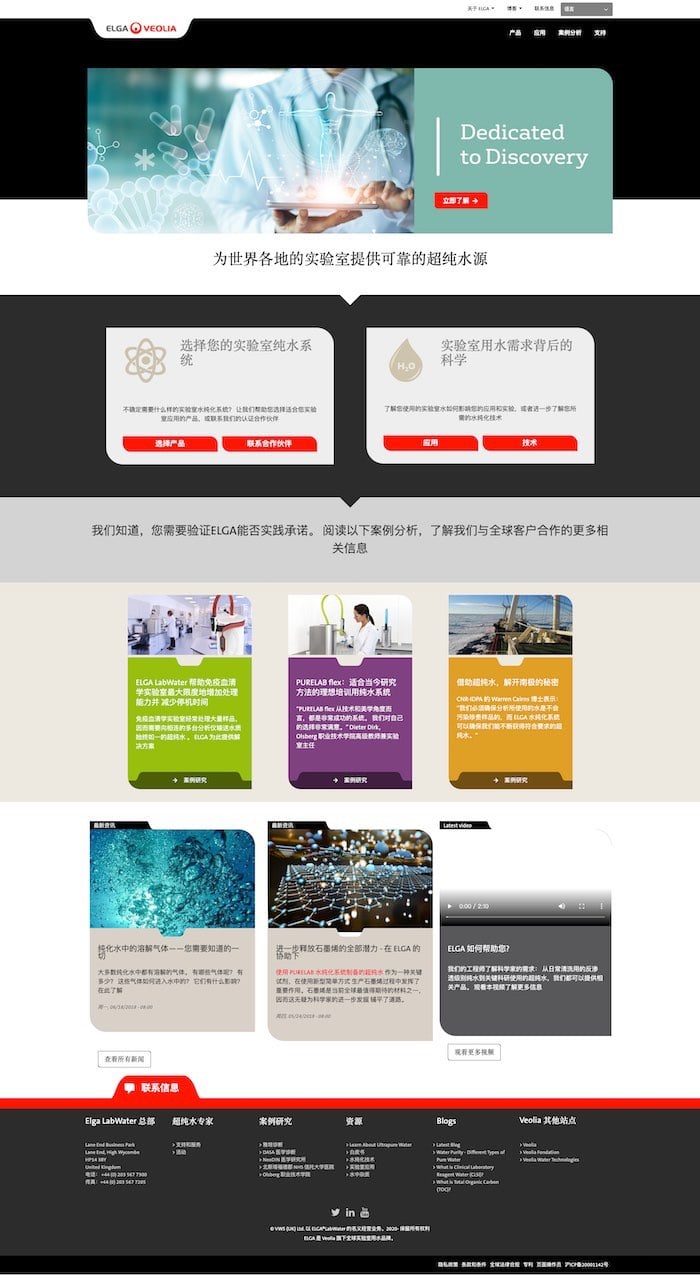According to Mckinsey Reports, Chinese consumption is expected to grow by about $6 trillion from 2019 through 2030. This enormous sum equals the combined growth expected in the US and Western Europe over the same period, and double that of India and ASEAN economies together.
To grow your business in this potentially huge market during the digital era, it is essential that you build an online presence with a solid localized Chinese website.
eMarketer predicts that China will account for more than 50 percent of global ecommerce in the coming year.

Source: eMarketer Global Ecommerce Forecast presented by ChannelAdvisor.
Because China has its own online ecosystem and unique regulatory environment, it is important that your localized website meets specific technical and legal requirements. Moreover, localized messages and content are needed to connect with and relate to the Chinese audience.
For the past two years, I have been working closely with several Nordic and European companies entering the market in China. One of the key foundational steps is to help them build a localized website. (See more here: 6 steps to a successful plan for marketing in China)
Here are some of my experiences and tips about the localization process.
Addressing the key issues of website localization
What are the key issues to address during the website localization process for China?
Many people think that localizing their websites for China market entry is just translating the content to Chinese. Actually, it requires much more than that.
A successful localization ensures that your content and messages can reach your target audiences smoothly by addressing issues such as relevancy, user experience, website navigation, APIs and integration, mobile optimization, hosting and government regulations.
To clarify this point, let’s start with an example of a popular function people like to use universally and every day; watching videos. If you post your product or service videos on YouTube or Vimeo in your home market, they will receive very limited or no access in China. How do you solve the problem and make them available to your target Chinese customers?
The most cost-effective and proven solution, based on our experience, is that during your localization process you:
- Localize your key product or service messages
- Add Chinese subtitles to the videos
- Host the videos on a Chinese server, which you can pay for on demand
Another bonus is that your local consumers will not be forced to watch advertisements before and after watching your videos (as they would on YouTube), which results not only in getting your messages out but also in a smooth user experience.
Some other important considerations:
Localized content is more relevant. Localization makes sure that your website content speaks to the target audience by using the local language with appropriate, professional industry vocabulary, technical words, idioms, lingo and cultural references, etc.
Localization can mean replacing APIs and integrations. You may need to replace some of your APIs that have no access in China with local equivalent options. For example, suppose you want to incorporate a map to your business on your website. If you use Google Maps API services on your main website, during the localization, you need to replace it with an equivalent option, such as Baidu Maps. Similarly, if you use Google Analytics, you may need to replace it with Baidu Tongji (Baidu Analytics), a similar Chinese application.
Local expectations require adjustments to navigation. Be sure you consider how to adjust your website infrastructure to meet local user expectations for easy navigation. Some Chinese consumers prefer to read detailed product pages with comprehensive descriptions and any testimonials, awards or certifications included. Under such circumstances, if you want to reduce their suspicion and build confidence while they study your product and service information, you may have to adapt page layouts to meet these expectations.
Localization should involve Chinese SEO. In order for your content to be searched and found by top local search engines such as Baidu, Qihoo360 (also known as Haosou) and Sogou, consider what optimizations need to be made.
Localization includes hosting in China. To improve loading speed and ensure your target customers have a good user experience, it is best that you host your site in China. The localization process includes applying for an Internet Content Provider (ICP) license in compliance with the government requirement.
Local payment processing may be needed. If your business involves ecommerce, the localization process will require implementing payment services from vendors like Alipay, WeChat Pay, UnionPay, etc., and you’ll also need to address logistics integration with local service providers.
How to successfully localize your website for China
Here are three key steps to help you plan your website localization process for the Chinese market:
1. Start with a well-thought-out strategy and planning
A website localization strategy needs to be well thought out and considered along with your overall strategic goals and your broader marketing strategy for the Chinese market.
For example, if you have a long-term strategic goal of China market entry and want to do all the local digital marketing right in the next phase, including Baidu SEO and SEM marketing, it is strongly suggested that you host your website in China and do the SEO while you are doing the localization. Because if you do not host your localized website in China, it will have very limited or no effect when you try to utilize Baidu SEO and SEM.
Some questions to consider as you start to plan:
- How do you host a website inside China? First, you’ll need an ICP license. To apply for the license, you need to consider the Chinese domain name, server and hosting. The application takes time and effort, so plan well ahead.
- What is your SEO strategy to help you achieve top ranking in Chinese search engines like Baidu, Sougou and 360?
- Will you keep the same user interface (UI) and user experience (UX) design, or do you want to fine-tune it?
2. Define the key content and messages for translation
This step will give you an overview of the scope of the localization project and what you need to translate and localize. Some pages that work in your home country might not work in China due to the cultural differences and differing habits of absorbing information.
Make a list of essential pages that will help the potential local customers understand your products and services. Walk them through all the actions to take, e.g., to scan the barcode to follow your WeChat, fill out a contact form to subscribe to your membership, make a donation or purchase, etc.
Here are some basic and essential pages to consider for localization:
- Home page
- About Us page
- Contact UP page
- Products/Services page
- Landing pages for a paid traffic or a campaign
- Conversion pages like registration
If you also have a WeChat Official account, make sure it connects, matches and points to your website so that they can bring traffic to each other.
One question worth asking here is: do you want to have a Chinese name for the market in China? Name is your key branding message and you want your customers to know you, remember you and like you as quickly and long as possible. A Chinese name generally helps a lot, as it has done for Coca-Cola, KFC, Starbucks, etc.
Based on our experience, if your name is hard for Chinese people to pronounce, then it is also hard for them to remember. So, the earlier you integrate your naming strategy into your localization process, the more cost effective it is.



3. Work with a bicultural marketing agency as your localization partner
Working with a localization expert agency can help you strategize and streamline the whole localization process, address critical issues, and ensure that everything is delivered to your expectation before the target deadline.
The right agency partner will also help you pick the best tools to streamline the localization process. For example, if you use Google Fonts and Google Analytics in your native website, as part of the localization process, the Google font would be replaced with the relevant Chinese font, and Google Analytics changed to Baidu Tongji.
Moreover, to avoid any legal issues and penalties, a good localization partner can help ensure that your website translation and marketing content abide by the local laws and regulations, e.g., the Advertising Law of China.
Ensure your localization is successful
To conclude, localization basically involves three totally different areas of work: administration, technical and content translation. Each of these areas requires talents with different skill sets, professional backgrounds and language abilities.
A bilingual marketing agency with extensive experience in website localization for the Chinese market can equip you with an experienced team including specialists who know the whole registration and set up process. This includes how to apply for an ICP license, experienced linguists, translators and industry professionals who can localize your content and polish it to meet the industry standards, along with designers and developers who can handle all the technical issues during the process. Together they will deliver a successful website localization.
Find out more about how UP FOR ASIA can help you on your localization journey.
Have a question? Feel free to ask it below in the comments, or sign up for a brief consultation to discuss it.

